Related Research Articles

Oskar Kokoschka was an Austrian artist, poet, playwright, and teacher best known for his intense expressionistic portraits and landscapes, as well as his theories on vision that influenced the Viennese Expressionist movement.

The Universität der Künste Berlin, situated in Berlin, Germany, is the largest art school in Europe. It is a public art and design school, and one of the four research universities in the city.

Joachim Ringelnatz is the pen name of the German author and painter Hans Bötticher (7 August 1883, Wurzen, Saxony – 17 November 1934, Berlin). His pen name Ringelnatz is usually explained as a dialect expression for an animal, possibly a variant of Ringelnatter, German for Grass Snake or more probably the seahorse for winding ("ringeln") its tail around objects. Seahorse is called Ringelnass by mariners to whom he felt belonging. He was a sailor in his youth and spent the First World War in the Navy on a minesweeper. In the 1920s and 1930s, he worked as a Kabarettist, i.e., a kind of satirical stand-up comedian. He is best known for his wry poems, often using word play and sometimes bordering on nonsense poetry. Some of these are similar to Christian Morgenstern's, but often more satirical in tone and occasionally subversive. His most popular creation is the anarchic sailor Kuddel Daddeldu with his drunken antics and disdain for authority.
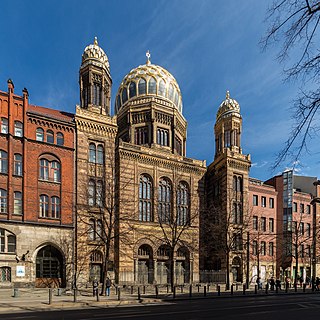
The New Synagogue on Oranienburger Straße in Berlin is a mid-19th century synagogue built as the main place of worship for Berlin's Jewish community, succeeding the Old Synagogue which the community outgrew. Because of its eastern Moorish style and resemblance to the Alhambra, the New Synagogue is an important architectural monument in Germany.
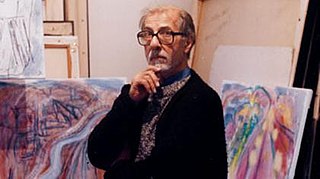
Ernest Zobole was a Welsh painter and art teacher. Zobole's paintings, originally oil on canvas, later switching to oil on board, reflected the industrial setting of the Rhondda Valleys. A member of the Rhondda Group, a circle of artists from the area, Zobole is seen as one of Wales' "most important artists...one of the visionary artists of Wales".

Portrait of Adele Bloch-Bauer I is a painting by Gustav Klimt, completed between 1903 and 1907. The portrait was commissioned by the sitter's husband, Ferdinand Bloch-Bauer, a Jewish banker and sugar producer. The painting was stolen by the Nazis in 1941 and displayed at the Österreichische Galerie Belvedere in Vienna. The portrait is the final and most fully representative work of Klimt's golden phase. It was the first of two depictions of Adele by Klimt—the second was completed in 1912; these were two of several works by the artist that the family owned.

Eric Fischl is an American painter, sculptor, printmaker, draughtsman and educator. He is known for his paintings depicting American suburbia from the 1970s and 1980s.

Günther Uecker is a German sculptor, op artist and installation artist.
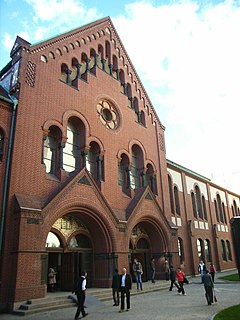
Rykestrasse Synagogue, Germany's largest synagogue, is located in the Prenzlauer Berg neighbourhood in the Pankow borough of Berlin. Johann Hoeniger built the synagogue in 1903/1904. It was inaugurated on 4 September 1904, in time for the holidays of and around Rosh Hashanah. The synagogue stands off the street alignment and is reached by a thoroughfare in the pertaining front building.

Stanislav Libenský and Jaroslava Brychtová were contemporary artists. Their works are included in many major modern art collections, such as the Metropolitan Museum of Art and the Victoria & Albert Museum.
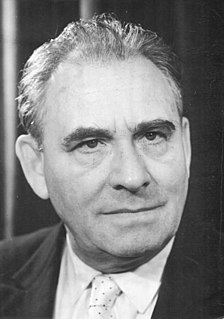
David Hirsch, known as Wolfgang Heinz, was an Austrian and East German actor and theater director. He served as President of the Academy of the Arts in Berlin between 1968 and 1974.
Karl Otto Götz often simply called K.O. Götz, was a German artist, filmmaker, draughtsman, printmaker, writer and professor of art at the Kunstakademie Düsseldorf. He was one of the oldest living and active artists older than 100 years of age and is best remembered for his explosive and complex abstract forms. His powerful, surrealist-inspired works earned him international recognition in exhibitions like documenta II in 1959. Götz never confined himself to one specific style or artistic field. He also explored generated abstract forms through television art. Götz is one of the most important members of the German Art Informel movement. His works and teachings influenced future artists such as Sigmar Polke, Nam June Paik and Gerhard Richter. He lived in Wolfenacker from 1975 until his death.

Heinz Mack is a German artist. Together with Otto Piene he founded the ZERO movement in 1957. He exhibited works at documenta in 1964 and 1977 and he represented Germany at the 1970 Venice Biennale. He is best known for his contributions to op art, light art and kinetic art.
Rabbi Dr. Adolf Rosenzweig was a German moderate liberal rabbi and Biblical and Talmudic scholar. In his publications he dealt with historical and archaeological matters.
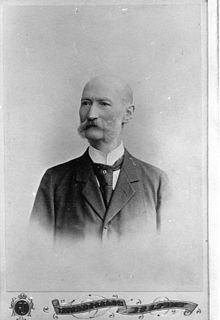
Moritz Landé was a German architect of Jewish origin. Landé was born in the Prussian Province of Posen. He was the son of Löbel Landé, a merchant from Ostrowo. Initially educated at his home under the supervision of a private teacher, he continued his studies as a master mason in Breslau. Finally he moved away to live with his uncle Jacob Landé, who was an architect. In 1857 he married Sophie Block. They had five children, one was Thekla Landé (1864–1932).
The 56 Group Wales is an artists' organisation founded in Wales in 1956, with the aim of promoting Welsh Modernist art and artists. The name was originally simply the 56 Group: "Wales" was added in 1967, in response to a feeling that the organisation's "Welsh origins ought to be re-affirmed". The Welsh-language version of the name was first used on publicity in 1976.

Genia Berger (1907–2000) was an Israeli artist, born in the Russian Empire.
Harry Weinberger (1924–2009) was an artist based in England. He was 'a trenchant defender of traditional painting', who fought against the dominant art school conventions of his day. Primarily a painter with a love of colour, Weinberger also taught art and illustrated books. He rarely painted people. Weinberger preferred to paint interiors and objects within them. He never dated his work. Harry Weinberger died at the age 85 on 10 September 2009.

Hermann Simon is a German historian who was for 27 years director of the Foundation "New Synagogue Berlin - Centrum Judaicum".
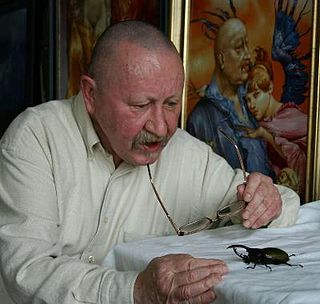
Heinz Zander, born 2 October 1939 in Wolfen, is a German painter, graphic artist, illustrator and writer. Zander belongs to the Leipzig School. His fields of work are painting (oil), drawing, graphics and illustration. He is also active as a writer and publishes novels, stories and essays. Zander worked with painting techniques oriented towards the Old Masters, from which he developed a completely independent pictorial language. He was inspired by Bosch, Grünewald, Altdorfer, Cranach and Italian Mannerists. He works mainly with colourful resin-oil glazes.
References
Notes
- ↑ "Lot 270: Renate Koppel (20th Century) Portrait of Cedric Morris". Bonhams . 2 December 2010. Retrieved 13 October 2020.
Renate Koppel nee. Fischl was a student of the East Anglian School of Painting and Drawing, she married artist Heinz Koppel in the 1940's.
- ↑ Rowan, Eric (1985). Art in Wales: An Illustrated History 1850 - 1980. Cardiff: University of Wales Press. pp. 125–129. ISBN 0-7083-1408-2.
- ↑ Pulver, Andrew (11 February 2010). "First Film award: Sleep Furiously". The Guardian. Retrieved 31 October 2014.
- ↑ "Gideon Koppel - Writer / Director". United Agents. Retrieved 29 October 2016.
- ↑ "Professor Gideon Koppel – Professor of Media". Manchester School of Art . Retrieved 26 May 2018.
Other sources
- Chana Schütz, Hermann Simon: Heinz Koppel. Ein Künstler zwischen Berlin und Wales. VBB, Berlin 2009, ISBN 978-3-86650-583-4 (Begleitband zur gleichnamigen Ausstellung der Stiftung Neue Synagoge Berlin – Centrum Judaicum, 30. August 2009–15. Januar 2010; in deutscher und englischer Sprache).
- Charles Samuel Spencer: Koppel, Heinz. In: Encyclopaedia Judaica . 2nd Edition. Macmillan, Detroit u.a. 2007. Bd. 12, S. 295.
- Ruthe, Ingeborg (28 August 2009). "Seine heillose Welt - Ein unbekannter Maler wird entdeckt: Heinz Koppels Bilder in der Neuen Synagoge". Berliner Zeitung (in German). Archived from the original on 14 September 2011.